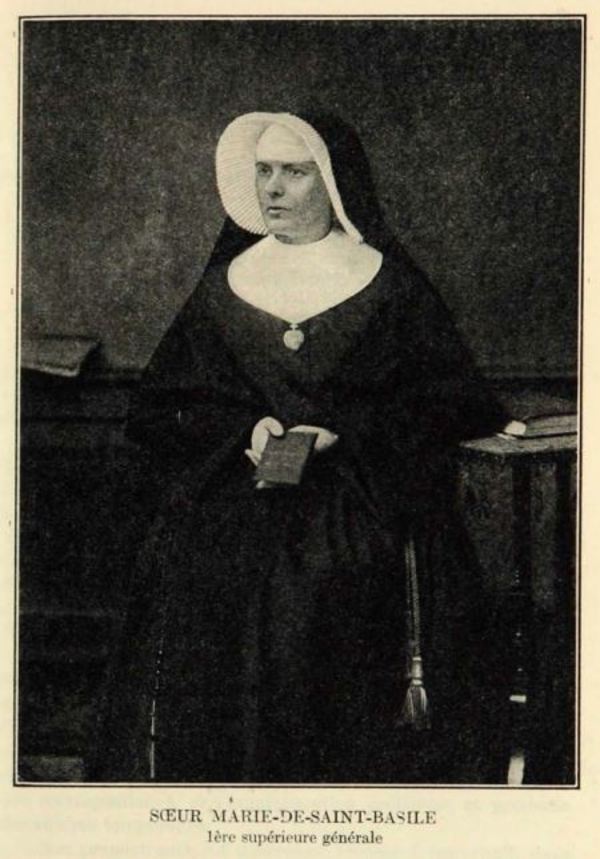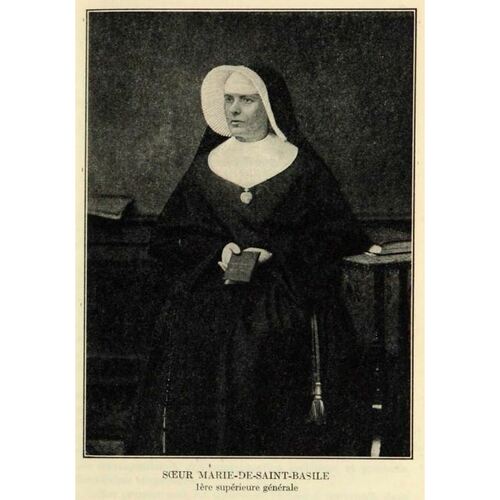
Source: Link
BERTRAND, JULIE (Julienne), named Marie de Saint-Basile, first Canadian superior general of the Sisters of the Holy Cross and the Seven Dolours; b. 1 Dec. 1844 in Sainte-Scholastique (Mirabel), Lower Canada, daughter of Olivier Bertrand, a carpentry contractor and farmer, and Julia Welch, who was probably of Irish descent; d. 2 April 1923 in Saint-Laurent, Que.
In 1851 Julie Bertrand began her studies at the local boarding school, which had been opened the previous year by the Marianite Sisters of Holy Cross. This French congregation had come to Saint-Laurent, near Montreal, in 1847, with the priests and brothers of the Congregation of Holy Cross, at the invitation of Bishop Ignace Bourget* [see Léocadie Gascoin*]. Accepted as a postulant in Saint-Laurent on 24 Aug. 1859, Julie entered the noviciate on 28 December; she was then given the name Sister Marie de Saint-Basile, in honour of Basile Moreau, the founder of the Congregation of Holy Cross.
As she had been a gifted student at the convent and had attracted attention as a novice, Sister Marie de Saint-Basile was assigned responsibilities in this teaching community, despite her youth: monitor, teacher, person responsible for the final academic year, academic director, and prefect of discipline. She worked in most of the houses in the province of Canada: Saint-Martin (Laval) from 1862, Saint-Laurent from 1865, Académie Saint-Ignace (Montreal) in 1873, Varennes in 1874, and Saint-Alphonse-de-Liguori (Saint-Liguori) from 1875.
While she was in Saint-Laurent and responsible for the final academic year, the young community was experiencing a major crisis. The Congregation of Holy Cross had branched out into the United States, and the French superiors were having difficulty managing the huge expansion of their establishment in Indiana, brought about through the efforts of Father Édouard Sorin. Léocadie Gascoin, named Marie des Sept-Douleurs, the founder of the Marianite Sisters of Holy Cross in Le Mans, France, and the second superior in Saint-Laurent in 1849, had become provincial in 1857 and superior general in 1858, but she had returned to France in 1863. From there she kept a tight rein on the administration of the Canadian province, in accordance with the constitutions. The three North American provinces (Indiana, Louisiana, and Canada) merged in 1865 and as a result the noviciate for all the North American houses of the Marianite Sisters was transferred to Indiana, despite the protests of the Canadian nuns. Then the American branch of the Marianite Sisters seceded from the mother house in 1869. The superior general now found that she had to curb the expansion of her Canadian branch, in order to remain faithful to the spirit of Moreau and avoid another split.
In 1876 Sister Marie de Saint-Basile was chosen for the difficult mission of setting up a boarding school in Sainte-Rose, a parish on Île Jésus that had been hoping for the arrival of another teaching congregation. To her success among the parishioners was added a further achievement: 24 of the 28 pupils in the final year of studies chose to enter the Saint-Laurent noviciate. It was as superior of this school that Marie de Saint-Basile became involved three years later in the steps taken by the nuns in Saint-Laurent to obtain their independence from the French congregation. Elected by the sisters as an official delegate to the meeting of the general chapter in 1879, she accompanied the provincial superior, Mother Marie de Saint-Alphonse-de-Rodriguez, to Le Mans. She found herself caught up in a conflict between the Canadian sisters and Marie des Sept-Douleurs, who, according to Bishop Édouard-Charles Fabre* of Montreal, “puts obstacles that hinder the development and prosperity of the establishments in the province.” After their delegates returned, the Canadian nuns, whose requests had been denied any consideration, sent a petition to Rome on 23 Aug. 1880 to sever all canonical ties with the French congregation. This move, which was seen by the founder as an unpardonable act of insubordination, was severely dealt with by exemplary punishments and changes of obedience, much to the confusion of the Canadian nuns. They held their ground, however, because having to refer all decisions to the general administration was causing major inconveniences. They had the support of Bishop Fabre, of Abbé Gédéon Huberdeau, a representative in Rome, and of their spiritual director in Varennes, Abbé François-Xavier Bourbonnais, who judged that the request of the Canadian nuns “was not an illegitimate revolt.”
After Rome had put an end, “for a time,” to all dependence of the congregation with regard to the mother house in December 1882, Bishop Fabre assumed oversight of it. He consulted with the nuns who had held positions of authority, chose the members of the council, and appointed Marie de Saint-Basile (who was only 38 years old) vicar superior of the Sisters of the Holy Cross and the Seven Dolours, as the “new” congregation was called. It may be surmised, then, that she was seen by her colleagues as a key figure in the separation and the logical person to accept the consequences of it. The situation was complicated by the fact that the former constitutions were still in effect. Mother Marie de Saint-Basile wrote to the bishop in 1885: “To reach an agreement with France is absolutely impossible. Our situation would be untenable.” Provisional constitutions were adopted in 1889 and the first chapter meeting, held in 1890, enabled Mother Marie de Saint-Basile to be elected the first superior general, an office to which she would be re-elected at the 1896 chapter meeting.
In 1882 the congregation consisted of 90 professed sisters and 22 novices. It had eight establishments in Montreal and the surrounding region, one in Ontario, and one in Connecticut. The new superior now began opening a string of houses, almost all located in the “Canadian” parishes of New England. Like many other religious orders in the province of Quebec, the Sisters of the Holy Cross found that region to be one where their expansion was unhindered by the presence of the older congregations and was facilitated by the development of the railway system. Marie de Saint-Basile directed this growth personally by making regular visits to the Franco-American houses. By 1902, when the superior general gave up her responsibilities, the congregation had undergone an unstoppable expansion: 428 professed sisters, 47 novices, and 28 postulants, in 33 different houses. It had been divided into three provinces – Notre-Dame-des-Sept-Douleurs (Quebec), Sacré-Cœur (New England), and Saint-Joseph (two houses in Ontario, four in the United States, and two in Quebec) – and the mother house had been enlarged by extensive building projects. Rome had issued a decree approving its constitutions in 1897, “after a wait of three years, rather than seven or ten years, because [they were] well drafted,” according to Marie de Saint-Basile. For her, these were “sweet consolations and powerful encouragements,” for she had often referred to “the heavy burden” of her responsibility.
Mother Marie de Saint-Basile, who had been in the front line of the struggle leading to the autonomy of the Canadian province, had exercised authority on the basis of prudence, respect for rules, and administrative skill. Her circular letters were short and effective, and seemed austere and repetitive: bans on travel and visits, restrictions on purchases, a search for the religious spirit in small things. Despite the difficult circumstances surrounding the foundation of the Canadian province, she maintained spiritual ties with the founders and with the other branches of Holy Cross. She recommended that “vocations be cultivated with good sense and discernment.” She also looked after the religious and pedagogical training of the young nuns, whom she brought together every summer at the mother house. Her correspondence was focused primarily on the material security of the congregation’s houses. Unfortunately she destroyed her personal papers a few months before she died, so that less official and more intimate insights are not available.
Following her term as superior general, Marie de Saint-Basile was provincial superior of the province of Notre-Dame-des-Sept-Douleurs until August 1905. She then took on less onerous responsibilities as local superior in Saint-Martin (1905–11) and in the parishes of Notre-Dame-du-Rosaire (1911–14) and Saint-Alphonse-d’Youville in Montreal (1914–20). In 1920 she returned to the mother house with the nuns who were sick, and she carried out simple administrative duties despite a chronic illness. She died on Easter Monday, 2 April 1923.
Mother Marie de Saint-Basile was remembered for the high regard in which she was held in her congregation and in the province of Quebec, doubtless because of the firmness and skill with which she led the Sisters of the Holy Cross under difficult circumstances. In the field of girls’ education, she offered skilful assistance to the prefects general of studies, who maintained the educational reputation of this congregation in the eyes of the public.
ANQ-M, CE606-S22, 1er déc. 1844. Arch. des Sœurs de Sainte-Croix (Saint-Laurent, Québec), Annales de la Congrégation des Sœurs de Sainte-Croix et des Sept-Douleurs, 2, 3; Circulaires de sœur Marie de Saint-Basile; Circulaires de sœur Marie des Sept-Douleurs; Correspondance, lettres de sœur Marie de Saint-Basile; Mgr Fabre avec la Sacrée Congrégation de Rome; sœurs de Saint-Laurent avec Mgr Bourget; sœurs de Saint-Laurent avec Mgr Fabre; Dossier concernant la pétition de 1882. Étienne et Tony Catta, La Très Révérende Mère Marie des Sept-Douleurs, 1818–1900, et les Origines des Marianites de Sainte-Croix (Le Mans, France, [1958]). Guy Laperrière, Les Congrégations religieuses: de la France au Québec, 1880–1914 (2 vol. parus, Sainte-Foy, Québec, 1996– ), 1. Sainte-Croix au Canada, 1847–1947 (Montréal, 1947).
Cite This Article
Micheline Dumont, “BERTRAND, JULIE (Julienne), named Marie de Saint-Basile,” in Dictionary of Canadian Biography, vol. 15, University of Toronto/Université Laval, 2003–, accessed April 3, 2025, https://www.biographi.ca/en/bio/bertrand_julie_15E.html.
The citation above shows the format for footnotes and endnotes according to the Chicago manual of style (16th edition). Information to be used in other citation formats:
| Permalink: | https://www.biographi.ca/en/bio/bertrand_julie_15E.html |
| Author of Article: | Micheline Dumont |
| Title of Article: | BERTRAND, JULIE (Julienne), named Marie de Saint-Basile |
| Publication Name: | Dictionary of Canadian Biography, vol. 15 |
| Publisher: | University of Toronto/Université Laval |
| Year of revision: | 2005 |
| Access Date: | April 3, 2025 |



